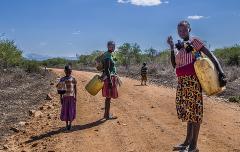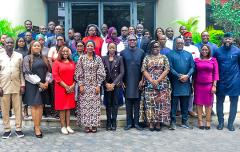Seven Takeaways From Tracking SDG7: The Energy Progress Report 2023
Despite a recent slowdown in the global pace of electrification, the number of people without electricity almost halved over the past decade, from 1.1 billion in 2010 down to 675 million in 2021.
The annual Tracking SDG7 report is produced to monitor global progress toward Sustainable Development Goal 7 (SDG7) and to offer a clear picture of how far we still need to go to ensure affordable and clean energy for all by 2030.
The report tracks global, regional, and country progress on energy access, energy efficiency, renewable energy, clean cooking, and international cooperation to advance SDG7. It presents updated statistics for each of the indicators and provides policy insights on priority areas and actions needed to spur further progress on SDG7, as well as related SDGs.
Here are our seven takeaways from the latest edition of the Tracking SDG7 report.
-
Significant progress has been realized when it comes to access to electricity.
Globally, access to electricity grew on average by 0.7 percentage points each year between 2010 and 2021, rising from 84 percent of the world’s population to 91 percent and raising the number of people with an electricity connection by more than a billion.
The number of people without electricity dropped by almost half, reducing the number of people without access from 1.1 billion in 2010 down to 675 million in 2021, despite a growing population, and this can be greatly attributed to the scaling up of distributed renewable solutions.
Most of the decline in the unserved population came in Asia. The number of people without access plummeted in Central and Southern Asia, falling from 414 million in 2010 to 24 million in 2021, with much of the improvement occurring in Bangladesh, India, and other populous countries.
-
At the current pace of electrification, most people without access by 2030 will live in Least Developed Countries (LDCs), countries affected by fragility, conflict, and violence, and people in rural areas.
Compared with the global average, the LDCs saw a relatively rapid increase in electrification, connecting about 32 million people a year between 2019 and 2021 and bringing the rate of access to 56 percent in 2021; however, it still leaves 481 million LDC residents without access. A gap of more than 30 percentage points persists in access rates between LDCs and the global average. In countries marked by fragility, conflict, and violence, access increased from 55 percent to 58 percent, leaving 421 million people still unserved in 2021.
Differences are also seen in urban versus rural access to electricity. In 2021, 98 percent of those living in urban areas had access to electricity, contrasted with just 85 percent in rural areas. Between 2019 and 2021, however, the pace of electrification was rapid in rural areas, where the number of people with access grew by 33 million a year, significantly outpacing population growth.
Dedicated financial and regulatory support should be strengthened to increase electrification in these settings. Furthermore, more needs to be done including improving the reliability of power, which continues to be a vital yet overlooked issue.
-
Sub-Saharan Africa is way off when it comes to clean cooking, and more needs to be urgently done – but let’s not forget China and India.
The world remains off track to achieve universal access to clean cooking by 2030. Up to 2.3 billion people still use polluting fuels and technologies for cooking, largely in Sub-Saharan Africa and developing Asia. Given current trends, the pledge made at the UN’s 2021 High-level Dialogue on Energy to ensure that an additional 1 billion people would gain access to clean cooking solutions by 2025 will not be reached.
Only 39 of the 128 countries still lacking universal access to clean cooking have set clean cooking targets, and less than half of those aim to achieve universal access by 2030. The number of people without access in the Sub-Saharan Africa region is growing at a rate of almost 20 million people per year as gains in access fail to keep pace with population growth.
The growing access to clean cooking deficit in Sub-Saharan Africa is significant, but we must not forget that India alone accounts for the largest share of the access to clean cooking deficit, with 505 million people lacking access, followed by China at 296 million, even with great progress in recent years from both countries. Therefore, we urgently need to ensure the inclusion of clean cooking within broader energy planning efforts to close the energy and cooking access gaps together in these countries and regions.
-
The share of renewable energy for heating and transport needs to be accelerated.
Renewable electricity use in global consumption has grown from 26.3 percent in 2019 to 28.2 percent in 2020, the largest single-year increase since the start of tracking progress for the SDGs. However, efforts to increase renewables’ share in heating and transport, which represent more than three quarters of global energy consumption, remain off target to achieve global climate objectives.
Heat is the largest energy end-use worldwide, accounting for half of the global final energy consumption. The sector remains heavily dependent on fossil fuels, which meet more than three-quarters of global heat demand. Renewable sources accounted for just 24 percent of the energy used for heat. Despite its dominant share in final energy consumption, the heat sector has received limited policy attention and support until very recently.
The transport sector is the end-use sector with the lowest renewable energy penetration, at only 4 percent of final energy consumption in 2020 and only 9 percent of worldwide consumption of modern forms of renewable energy. Liquid biofuels represented 90 percent of the renewable energy consumed for transport, with most of the remainder coming from renewable electricity for vehicles and trains, which expanded by 0.02 EJ year-on-year in 2020. A fraction of this growth is attributable to the growing number of electric vehicles on the road—from 7.1 million in 2019 to 11.3 million in 2020, while the electricity that powers these vehicles comes increasingly from renewable energy sources.
More needs to be done to expand infrastructure and upgrade technology for supplying modern and sustainable energy services for all with a special focus on developing countries, in particular Least Developed Countries (LDCs), Small Island Developing States (SIDS), and Landlocked Developing Countries (LLDCs).
-
Energy efficiency remains a low-hanging fruit.
Energy intensity – the measure of how much energy the global economy uses per dollar of GDP and the proxy indicator used to estimate progress on energy efficiency – improved from 2010 to 2020 by 1.8 percent annually. This is higher than the 1.2 percent improvement from the previous decades. However, the rate of energy intensity improvement slowed during the COVID-19 pandemic to the lowest point in recent years at 0.6 percent in 2020. This slow pace of improvement is a major missed opportunity for the global community to receive personal and societal scale benefits of energy efficiency.
The technology and services needed to double energy efficiency by 2030 are affordable, available, and effective, including digitalization, which is already reshaping the energy landscape and facilitating progress toward improved energy efficiency.
More efforts must be put in place to invest in energy efficiency measures through both personal decisions and as societal infrastructure investment decisions, which can have the greatest impact and bring modern energy services to more people. As an immediate step, energy efficiency must be made a priority in policies and programme investments.
-
International public financial flows have reduced and are concentrated in a few countries.
International public financial flows in support of clean energy in developing countries stood at USD 10.8 billion in 2021, 35 percent less than the 2010-2019 average and only about 40 percent of the 2017 peak of USD 26.4 billion.
In 2021, financial commitments were heavily concentrated in a handful of countries, with 23 countries receiving 80 percent of all commitments in 2020. In 2021, the number of countries receiving most of the commitments was fewer, with only 19 countries receiving the bulk of financial flows.
Economic and fiscal challenges such as high inflation, currency fluctuations, debt distress, lack of financing, and soaring material prices, coupled with the persistent impacts of the COVID-19 pandemic and rising energy prices since 2021, continue to pose significant hurdles especially for the most vulnerable countries.
Investments must therefore be urgently raised and deployed to deliver technologies and services, while having a supportive enabling environment through policy interventions at national, regional, and international levels.
-
Expanding access to affordable, clean energy will help achieve other SDGs.
Affordable, reliable, modern energy is a prerequisite for the attainment of other SDGs, notably SDG1 (zero poverty); SDG3 (good health and well-being); SDG4 (high-quality education); SDG5 (gender equality); SDG8 (decent work and economic growth); SDG9 (industry, innovation, and infrastructure), and SDG13 (climate action).
Regulatory and policy frameworks for electricity access should be designed to support innovations in energy technology and to leverage financing—for the ultimate purpose of providing affordable and reliable electricity, maximizing economic growth, increasing access to high-quality education, providing reliable electricity to power health facilities, integrating climate change considerations, and spurring women’s economic empowerment and gender equality.
Read the full SDG7 Tracking report here.




